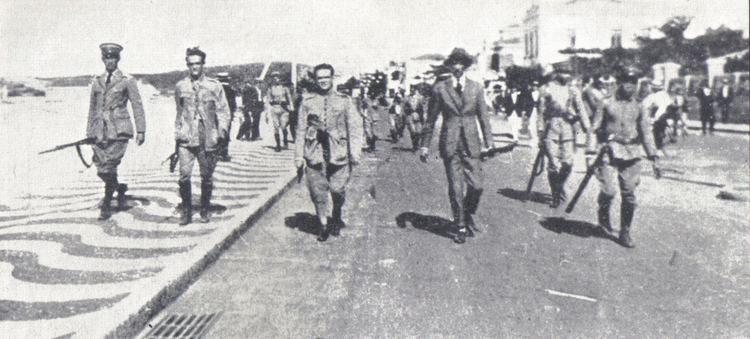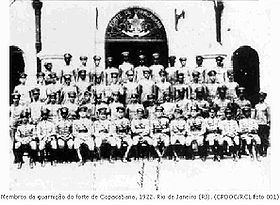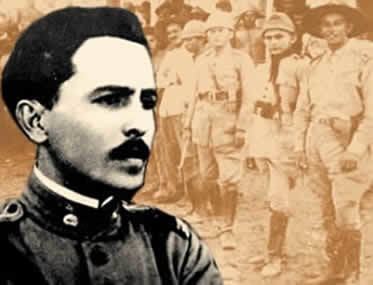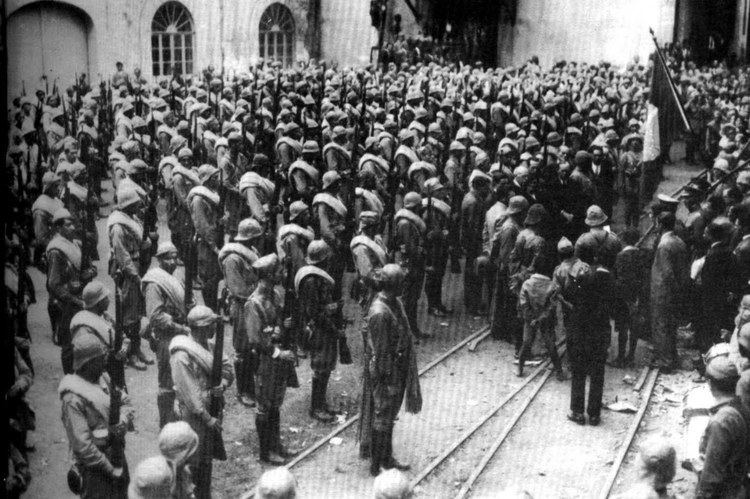 | ||
Result Loyalist victory, mutiny suppressed. | ||
Tenentism (Portuguese: tenentismo) was a political philosophy of junior army officers (Portuguese: tenentes, [teˈnẽtʃis], lieutenants) who contributed significantly to the Brazilian Revolution of 1930.
Contents
- Tenentismo
- Background
- July 1922 the first revolt
- July 1924February 1927 the second revolt and the Long March of the Prestes Column
- Legacy
- References

Tenentismo
Background

The first decades of the 20th century saw marked economic and social change in Brazil. With manufacturing on the rise, the central government—dominated by the coffee oligarchs and the old order of café com leite and coronelismo—came under threat from the political aspirations of new urban groups: professionals, government and white-collar workers, merchants, bankers, and industrialists. In parallel, growing prosperity encouraged a rapid rise in the population of new working class Southern and Eastern European immigrants, who contributed to the growth of trade unionism, anarchism, and socialism. In the post-World War I period, Brazil saw its first wave of general strikes and the establishment of the Communist Party in 1922.

A new class of army junior officer (Portuguese: tenente) had emerged who were trained to European standards and believed themselves superior to their senior officers. In addition, various senior officers had become identified with the government and political structure, a source of criticism from the tenentes.

Meanwhile, the divergence of interests between the coffee oligarchs and the burgeoning, dynamic urban sectors was intensifying. According to Latin American historian Benjamin Keen, the task of transforming society "fell to the rapidly growing urban bourgeois groups, and especially to the middle class, which began to voice even more strongly its discontent with the rule of the corrupt rural oligarchies". In contrast, despite a wave of general strikes in the post-war years, the labour movement remained small and weak, lacking ties to the peasantry, who constituted the overwhelming majority of the Brazilian population. As a result, rather disparate and disjointed social reform movements would crop up in the 1920s.
July 1922: the first revolt

What became known as the tenente movement came to public notice on 5 July 1922 when a group of young Brazilian Army officers began a rebellion against the Old Republic at Fort Copacabana in Rio de Janeiro. Sparked initially by the punishment and brief imprisonment of Marshal Hermes da Fonseca by President Epitácio Pessoa, they were demanding various forms of social modernization, calling for agrarian reform, the formation of co-operatives, and the nationalization of mines.

Their early-morning rebellion was taken up by a garrison in São Paulo but not by others; only "scattered units around Rio de Janeiro revolted: the Escola Militar, some elements of the First Infantry Regiment and the Battalion of Engineers, and the garrisons of Forts Copacabana and Vigia. However, the remainder of the First Army Division stayed loyal and, with General Setembrino de Carvalho supervising the operations, easily crushed the revolt". Twenty-four hours later, just 200 rebels remained when the navy dreadnought Minas Geraes shelled the Copacabana barracks, after which two navy aircraft bombed the barracks in the first use of naval aircraft in combat in Latin America. The defenders were driven from their positions. A group known subsequently as the 18 of the Copacabana Fort revolt were led down Avenida Atlântica by Antônio de Siqueira Campos and Eduardo Gomes to confront the army loyalists; the eighteen made a last stand on the beach, where sixteen were killed and two, Gomes and de Siqueira Campos, survived. In the aftermath, the government imposed a state of emergency, 1,000 cadets were expelled from the army school and many officers posted to remote garrisons.
July 1924–February 1927: the second revolt and the Long March of the Prestes Column
Two years later, on 5 July 1924, another group of army officers mounted a rebellion in São Paulo and Rio Grande do Sul. The date was chosen to honour the 1922 rebels; the uprising "was better prepared and was intended to bring down the Bernardes government". The formal leader was retired General Isidoro Dias Lopes, with others including Eduardo Gomes, Newton Estillac Leal, João Cabanas and Miguel Costa. The rebellion began well, with control of São Paulo being secured after the governor and forces loyal to him abandoned the city early on 9 July. The rebels in the city were put under siege by government forces, and prevented from linking up with other uprisings which were breaking out in places such as Bela Vista, Mato Grosso, Aracaju, Sergipe and Manaus. The city was then subjected to a several-week artillery and aerial bombardment, of which civilians bore the brunt. On 26 July, army aircraft dropped leaflets over the city warning the remaining civilians to leave so that loyalist forces would have a free hand against the rebels. "Isidoro's various attempts at securing an accord with the government that would at least give the rebels amnesty were rebuffed. The leaders understood that they would be wiped out, along with a good part of the city, if they stayed. On the night of 27 July they staged a careful withdrawal of 3,000 troops on thirteen trains, via the Northwest Railroad, toward Mato Grosso, where they hoped to hook up with sympathetic units". This withdrawal was executed so smoothly that it went unnoticed by the government forces until the morning. However, with their route to Mato Grosso blocked, the rebels retired to an area bordering Argentina and Paraguay close to Foz do Iguaçu.
Having escaped into the interior, and joined by others from Rio Grande do Sul, they began a campaign as a guerrilla force led by Luís Carlos Prestes and Miguel Costa. They became known as the Prestes Column, and covered some 25,000 kilometres from October 1924 to February 1927 "as they roamed through the interior of the country (...) seeking unsuccessfully to promote mass rebellion or at any rate to act as a moral gadfly to the nation's conscience". After losing significant numbers to desertion and sickness, escaping encirclement at Palmeira, Rio Grande do Sul in January 1925, making a successful stand at the Iguaçu Falls in February and "[a]fter some initial disagreements about strategy, the rebels adopted one that amounted less to a war of movement than a moving 'armed protest demonstration' that would serve as a constant call to action against the hated Bernardes. The idea was not to defeat the forces sent against them, much less the old objective of seizing power in Rio de Janeiro: the objective now was to stay alive, keep the column moving and seemingly invincible. In that, they succeeded as they moved through state after state from Mato Grosso to Maranhão and back, before seeking refuge in Bolivia in 1927".
Regarding the 'Long March', Prestes subsequently wrote that "the tactics of swift marches, evasion as far as possible of contact with superior enemy forces and surprise attacks aimed at demoralizing the enemy and capturing arms and ammunition, demonstrated that in Brazilian conditions it was possible to stage a protracted struggle".
However, years later he was critical of the futility of his own strategy, writing that "I also defended the column's march tactics, claiming that they presented opportunities for recruiting new fighters. This, however, was not the case. The farmers sympathised with us for the simple reason that we were against the oppressors, they admired our heroism and devotion, but had no intention (with rare exceptions of some young people) of committing themselves to a struggle in whose success they could not believe".
Legacy
The tenente revolts heralded the end of the politics of café com leite and coronelismo and the beginning of social reforms. The actions and ideas that grew out of the revolts inspired other individuals, such as Getúlio Vargas, to lead the 1930 revolution against the Brazilian Government and bring down the Old Republic. "The tenentes became the most visible proponents for revolution and helped convince Vargas that the use of force would be necessary". Subsequently, with the help of the tenentes, whom he restored to the army, often with significant promotions, Vargas "forged a highly personalised dictatorship". Prestes, however, "proclaimed his opposition to the 1930 coup and formally applied for membership of the Communist Party".
